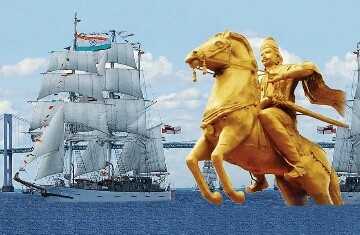PREVIOUS
The naval prowess of Rajendra Chola I
August 3 , 2025
86 days
571
0
- Naval supremacy drove the Chola empire to the height of glory.
- Under the dynamic leadership of Rajendra Chola I, the Chola navy reached the zenith of its power.
- He ascended the throne in 1012 CE
- With nearly the entire southern peninsula of India under their dominion, the Cholas commanded an unobstructed access to the seas.
- By that they turned into a theatre of unprecedented political expansion.
- Rajendra’s reign marked the most assertive phase of Chola overseas ambition.
- The naval campaigns launched during this period led to the annexation of Sri Lanka and an audacious expedition across the Bay of Bengal to the distant shores of the Malay Peninsula.
- The Victory over Malay Peninsula earned Rajendra the title Kadaram Kondan (the Conqueror of Kadaram).
- The existence of a well-organised fleet of ships and boats of various grades in Chola’s navy served both commercial and military purposes.
- K. A. Nilakanta Sastri, in his book The Cōlas, had offered a detailed account of Rajendra’s naval campaigns.
- It was particularly those targeting Eelamandalam (Sri Lanka) and Kadaram, the strategic stronghold in the Kingdom of Srivijaya.
- In 1017 CE, Rajendra launched a decisive campaign against Sri Lanka.
- This was the fifth year of his reign.
- And it marked the culmination of the efforts initiated by his father, Raja Raja Chola I.
- The Chola conquest coincided with the thirty-sixth regnal year of the Sinhalese ruler Mahinda V.
- It was according to inscriptions and the Ceylonese chronicle Mahavamsa.
- It was dated to 1017 CE.
- The Chola involvement in Sri Lanka stretched back to the reign of Parantaka Chola I, who ruled from 907 to 955 CE.
- However, it was Raja Raja who annexed the northern parts of the island.
- Though some territories remained under local Sinhalese control, the Chola grip steadily tightened.
- Rajendra’s offensive went further than that of his father.
- His forces captured Mahinda V and seized the royal regalia, including the crown.
- His control over the island was comprehensive enough to convert it into a full-fledged Chola province.
- Inscriptions bearing the title, tirumanni valara, attributed to Rajendra, were also found near Polonnaruwa in Sri Lanka.
- Temples built in the Tamil Chola architectural style, dedicated to deities such as Shiva and Vishnu, further underscored Chola influence.
- Around 1029 CE, 12 years after the invasion, a fresh wave of unrest erupted.
- Kassapa, son of Mahinda V, who had been raised in secrecy, led a very successful rebellion.
- After six months of conflict, he regained control and ruled as Vikkamabahu I, re-establishing Sinhalese sovereignty.
- Rajendra’s imperial vision did not stop with Sri Lanka.
- In 1025 CE, soon after his campaign to the Ganges, he turned his gaze eastward towards the thriving maritime Kingdom of Srivijaya.
- This Southeast Asian empire controlled vital sea lanes connecting India to China and ruled over territories that included the Malay Peninsula, Sumatra, and Java.
- Initially, relations between the Cholas and Srivijaya were cordial.
- Raja Raja Chola had granted some land in Nagapattinam to Mara Vijayottunga Varman of the Shailendra dynasty for the construction of the Chudamani Vihara.
- Diplomatic missions moved regularly between the two kingdoms and China.
- Srivijaya sent envoys in 1003 and 1008 CE, while the Cholas reciprocated the gesture in 1015, 1033, and 1077 CE.
- Inscriptions on the Tiruvalangadu copper plates merely mentioned the conquest of Kadaram.
- While a Tamil prasasti (an inscription in praise of a ruler) provides some more details.
- One view attribute the conflict to interference by Srivijaya in Chola maritime trade.
- While another sees it as part of Rajendra’s broader ambition to achieve maritime supremacy and secure overseas prestige.
- Rajendra’s Southeast Asia campaign was swift and decisive.
- The Chola ships had crossed the Bay of Bengal and struck at the heart of Srivijayan power.
- Kadaram was captured and Sangrama Vijayottungavarman, successor to Mara Vijayottungavarman, was taken prisoner.
- While the campaign had projected Chola’s might across the seas, there was no immediate attempt to establish direct rule over the conquered territories.
- Rajendra’s successor, Virarajendra I, claimed to have reconquered Kadaram and restored its ruler, indicating that earlier gains were only temporary.
- A Tamil inscription from Sumatra, dated to 1088 CE, provides further evidence of continued Chola activity in the region.
- It was at least in terms of commerce.
- Beyond the military conquests, these expeditions highlighted the Chola empire’s broader diplomatic reach.
- Inscriptions in the Karandai copper plates indicated that the King of Kambhoja (the Kingdom of Angkor ruled by Suryavarman I) had solicited the friendship of Rajendra by sending him a victorious war-chariot with which he had defeated hostile armies.
- Rajendra’s naval expeditions marked a bold chapter in history.
- They extended both political and cultural reach of the Chola empire beyond the Indian subcontinent.

Leave a Reply
Your Comment is awaiting moderation.


